|
JULY 2021
|
|

|
|
extrapolated
from a drawing by David Lance in the 1964 Comet Yearbook
|
|
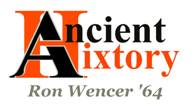
|
Normally,
AH focuses on history in the
context of a single person, event, movement, etc.
This time around is different: it looks more broadly at
life, from birth through high school, as experienced by the
earliest Baby Boomers (who happened to correspond to the Class
of 1964) and their families.
The
following blend of nostalgia and history has been extracted from
a handout given to those who attended that class's fifty-fifth
anniversary reunion. This
is the first of two installments.
|
|
An
Arbitrary Look Back at Our World, 1946-1964
|
|
PART
I: 1946 into the 1950s
|
This is our tale, the story
of the members of the Class of 1964 - sort of.
It's not about what happened to so-and-so, or who did what in
high school. But it is about
the world we once lived in, from the time we were born, until the summer
of 1964. Fifty-five years
later, if once in a while we look back at that world, it's only
natural to wonder if we've forgotten anything.
After all, day by day, year after year, we've probably had to
deal with more "little changes" in the world around us than any
previous American generation.
Hmmmpf,
you say, you remember things just fine.
Let's see if that's true.
Although this little quasi-history is not specifically about
sports, we'll start with a baseball question, because lots of us grew
up watching it and hearing about it.
It would be impossible to forget the
New York
teams of 50s and 60s, right? In
the nineteen seasons from 1946 through 1964, the Dodgers,
Giants, and Yankees
regularly were among baseball's best.
As a group they compiled astoundingly high numbers of World
Series victories and appearances. Question:
Which MLB team got both World Series victories that book-ended those
years?
Answer: In 1946, and again in 1964, the Series winner was... the
St. Louis
Cardinals!
Hmmmmmmm...
We
Make Our Debut
|
When our parents brought us home from the hospital,
many of us got our first automobile ride.
Most likely, we were first swaddled to protect us from
the weather, and then we were tucked lovingly into a cozy little
"bassinette" (which in some cases looked a lot like a
painted fruit basket).
|
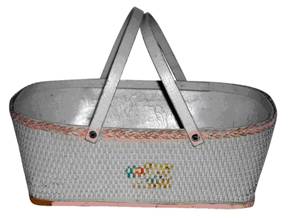
|
|
|
1940s bassinette
rubylane.com
|
|
Into the back seat we went, perhaps to ride in a
shiny new post-war Packard
or DeSoto taxi,
|
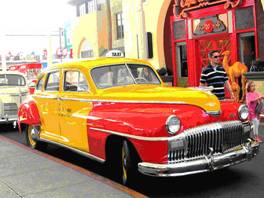
|
|
|
1946
DeSoto Taxi
Wikimedia Commons
|
|
or in our parents'
Hudson
, or maybe in our Uncle Henry's Studebaker.
|

|
|
|
1946 Studebaker coupe
Flickr
|
While most of us soon were cozy in our cribs, our
parents sometimes worried. Even
if we seemed healthy, there were risks ahead. Certain childhood diseases
still were not preventable, although the new antibiotics offered
optimism - secondary infections often could be controlled, and fewer
children would die. Influenza
would come around again, and it would be hard on children.
Although tuberculosis often was curable, it was still around; 4
out of every 10,000 Americans had it.
Any nearby coughs would make our folks nervous.
Polio frightened our parents more than any other disease.
There was good cause to worry. For decades, it had been on the
rise. In 1952, the year most
of us would begin First Grade, 60,000 American children would contract
polio. It would kill 3,000
of them, and thousands of the survivors would live afterwards with
partial or total paralysis. Some
of them would be confined to iron lungs well into adulthood.
|
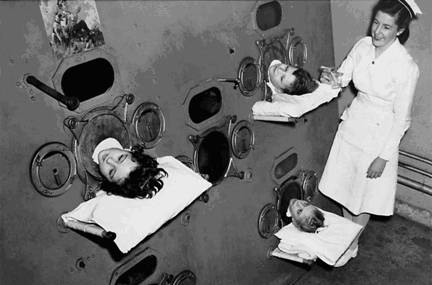
|
|
So many children got polio that there were group iron
lungs.
Boston
Children's Hospital Archive
|
Despite all the gloomy possibilities, 1946
gave Americans at least three reasons to feel positive about their
families' health prospects. President
Harry Truman proposed, and was given Congressional assistance for,
Federal loans to communities to establish improved levels of hospital
care across the country. The
CDC (originally called the Communicable
Disease Center) was created. The
National School Lunch Act established
a framework for promoting childhood nutrition.
Where
We Were Born (and how that mattered)
Around World War I, commuting had become more feasible,
and a number of city residents had relocated to
Hicksville
. Even so, before the
stunning population growth that began around 1945, the village's
population was only a fraction of what it would be by the time we began
school.
1950s newspapers reported that throughout the county, the population was
swelling, and that a large majority of the new-home buyers had come from
New York
. Indeed, as elsewhere in
Nassau
, well over 50% of Hicksville High's Class of 1964 was city-born.
So many families' moving to
Hicksville
in a few years overwhelmed and changed it.
Population density was only part of the story.
Newcomers brought with them their city values, customs, and
expectations. Although their
neighborhood was new, people quickly turned it into something familiar,
because at heart, they were New Yorkers, and they needed lots of city
things, like pizza, and bagels.
By the way, whether you were born in a truly rural area
or in
Nassau
County
, you got lots of fresh air in
Hicksville
. But of course, that was
possible in the city, too - provided that you and your mother were up
for it, and provided that the pigeons and mosquitoes
stayed away:
|
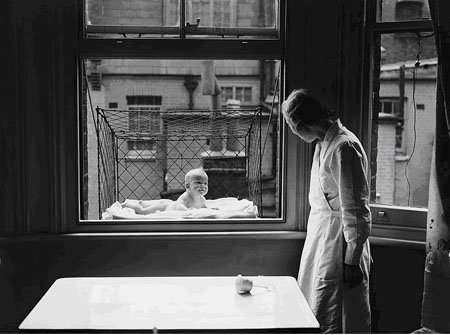
|
|
Just don't tell your grandmother about this, OK?
goodhousekeeping.com
|
Starting
to Learn
We learned a lot by listening.
Back in my
Queens
home, I got to know the sound of a bus stopping at the corner.
Whenever I heard the garbage truck come by, I'd run to the
window, grab the sill, and stretch up to watch.
I recognized the sound of the knife-sharpener's gong, and the
clopping of the mounted patrolmen's horses' hooves.
For many of us, the familiar "white noise" of
traffic was punctuated by the chugging and shrill whistles of steam
locomotives, especially on hot summer nights when the windows were open.
La
Guardia gave us intermittent aircraft noise, and there soon would be
much more of that. A second
New York
airport, commonly called Idlewild,
began operating in 1948.
|
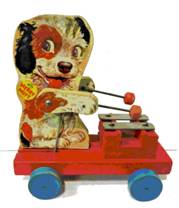
|
Once we were old enough to attempt walking, some
well-intentioned family friend gave our parents a pull toy.
Pull toys inevitably made the same noise - loud clicks,
or xylophone notes - over and over.
And over. We
drove our parents crazy as soon as we learned how to multitask
(i.e., by walking and pulling at the same time), and the more
noise we made, the happier we were.
|
|
1949 Fisher-Price Merry Mutt
ebay.com
|
|
We watched bigger kids play outside, and were eager to
be old enough to join them. It
made a difference if you lived on a street that didn't curve.
Straight streets let kids see if a car was coming, and it was
easier for our parents to spot us if we wandered down the street a house
or two. Being able to see
corner-to-corner gave us a sense of belonging - it was "our
block."
Outside, games like tag or hide-and-seek
were played by boys and girls together; games with equipment seemed more
like sports, and they usually were single-gender.
|
Pink rubber balls (often called Spaldeens, after Spalding, who manufactured the best ones) gave us
the most fun per ounce of anything we owned.
Kids played catch, or they put a bottle cap on a sidewalk groove, stood on
opposite sides, and bounced a ball to each other, counting who
hit the target most often.
Girls would steadily bounce a ball, lifting a knee
over it each time before it bounced back.
"A, my name is
Alice
..." they'd begin, trying to reach the end of the
alphabet without stopping.
|
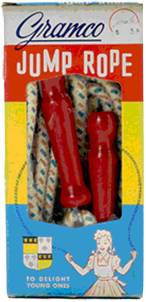
|
|
|
Gramco Jump Rope
toyhalloffame.org
|
Boys used Spaldeens for stickball
and handball. Or, a boy
could throw one hard against his home's front steps, so that it
bounced back as a pop-up or a fly ball for his buddies to catch.
A variant of catch was
tossing the ball diagonally up on our home's slanted roof, so that it
rolled or bounced down to a buddy waiting at the other end of the yard.
The sidewalk was the place for potsy,
and for simple rope jumping.
Driveways were a good choice when two girls stood apart and kept
a rope going, their friends taking turns jumping in.
They chanted rhymes, for fun, and also to help maintain the
rhythmic motion of the rope.
Home
Entertainment
|

|
Television was almost ready to unseat radio as the
primary medium for home entertainment, except that the coaxial
infrastructure needed for national network broadcasting was not
yet completed. Until
it was, radio would hold on, and our parents would keep
listening.
|
|
Agnes Moorehead and sound-effects man in a live
broadcast of "Sorry, Wrong Number"
WHAV.net
|
|
|
In 1946, the nation's top radio shows were a
potpourri of live dramas, variety shows, and situation comedies.
Some of them we may now know only by title, if at all:
Lux
Radio Theatre, Fibber McGee and Molly, Suspense, The Kate Smith
Show, The Bickersons, Inner Sanctum, The Edgar Bergen and
Charlie McCarthy Show, Truth or Consequences, The Adventures of
Sam Spade, The Fred Allen Show
No one minded that the lips of Edgar Bergen - whose
humor was based on his being a ventriloquist - could not be
seen on his hit radio show.
Nor that you could not see the dancing on Saturday
night's National Barn
Dance.
Radio performers whom we recognize because they later
would transition to TV included:
Bing
Crosby, Burns and Allen, Bob Hope, Jack Benny, Red Skelton,
Abbott and Costello, Jimmy Durante, Garry Moore, Jack Webb
|
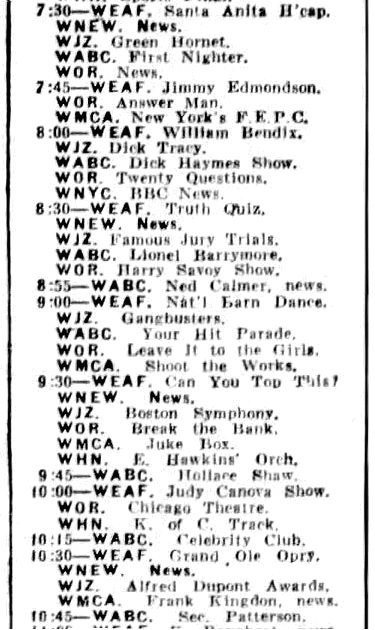
Radio
listing for evening of March 9, 1946
New York
Daily News
|
Soon to begin their successful runs on television were
radio favorites Dragnet, Richard
Diamond, and Gunsmoke.
Never at the top with her own radio show was
Dinah
Shore
, but she would have great success on television.
Our parents also listened to, and we heard, lots of,
recorded music. According to
Billboard, these were the performers of 1946's ten top-selling
hits: The Ink Spots, Perry Como,
Frank Sinatra, Freddy Martin, Vaughn Monroe, Frankie Carle, Johnny
Mercer, and Nat "King"
Cole. Having held down
the Number 1 spot for ten weeks, The
Ink Spots' record of "The Gypsy" was the hit of the year.
Echoes
of World War II
|
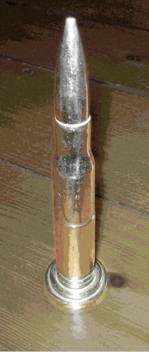
Cigarette
lighter
ebay.com
|
Reminders of the war were everywhere.
My father's table-top cigarette lighter, like the one in the
picture, had been made from a chromed .50 caliber machine gun
shell. As a young
child, I had a sturdy gyroscope.
It should have been part of an Army
Air Force bombsight, but it had failed inspection at the
defense plant. When
I first was old enough to play with it, my father had to tell me
what a bombsight was.
I doubt that anyone ever explained to me what a war was, but
little by little, I had got the idea.
It was only natural that we'd hear about it.
Many of our relatives had served in the military or
worked in defense plants during World War II, and American
families had had to deal with rationing, shortages, and the pain
of losing loved ones.
|
With my family, I watched uniformed veterans march in
parades: Look, there's Dad's
godson Joe - he was a Marine in the South Pacific.
Even ordinary visits with relatives would bring up memories of
the war: Cousin Harold has very
bad hearing from firing all those artillery shells during the war.
Or, Aunt Martha's son
Bill died when his ship was sunk by a Kamikaze at
Okinawa
. I saw a framed
photograph of my Uncle Gus, wearing a uniform and Stetson hat, stiffly
seated on horseback: That's from
the FIRST world war. And
so I learned that there had been more than one war.
|
As far back as I can recall - before
Hicksville
- I'd see signs with a large black S
and an arrow.
That's
from the war. It
showed you where to go if the Nazis bombed us.
|
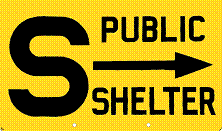
|

|
|
Something new for me to think about.
|
NYC sign designating place to use as shelter during
WW II Air Raids
picclick.com
|
Civil Defense roundel
amazon.com
|
Once when the streets got washed, I asked about the
round signs on the Department of Sanitation tanker trucks that sprayed
the pavement: CD stands for
'Civil Defense.' I
vaguely got the idea, but I wasn't ready to find out more.
Much later, my Fourth Grade teacher in
Hicksville
, Evelyn Storey, would tell our class about the Office
of Civil Defense, and about her wartime experiences as an Air Raid
Warden.
Understandably, our parents were never going to forget World War II.
Making
a New
Hicksville
Let's
take a look at what
Hicksville
was like when we first arrived.
|
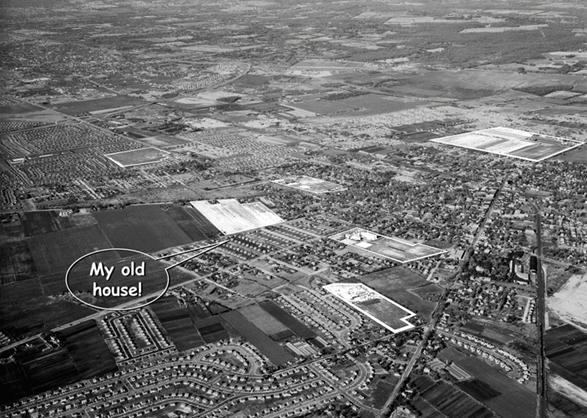
|
|
1951
Fairchild Aerial
Survey view of Hicksville (enhanced by author)
NYS
Archives, Aerial photographic prints and
negatives of
New York
State
sites, 1941-1957
|
The
highlighted rectangle on the right is the site of the future Mid-Island
Plaza. Looking below it
and a little left (south) along Broadway, we see the grounds and older
buildings of what we later called "our" junior high.
Further south are the grounds of Lee
Avenue School, already under construction.
The field visible just above my old home on
7th Street
is the farmland on which our high school will be built in a few years.
A few blocks north, at Newbridge and Old Country Roads, the Center Shops plaza is partially built, but the parking lot is not
yet paved. To the west of
it, beyond
Plain
Lawn
Cemetery
, outlined in white is the future site of
Old
Country
Road
School
.
The
new homes in the foreground are easy to spot.
To the north, there's a great ocean of whitecaps - thousands
of new homes with not a tree in sight.
It's 1951, and already new homes vastly outnumber
Hicksville
's pre-war buildings.
Note:
Not all of us lived in new houses,
but I'm about to sound as if we did.
It's not that I favor post-war houses (on the contrary; the
house I live in is more than a century old).
But
Long Island
's post-war houses were seen as emblems of a new era, the one into
which we had been born.
In
the Kitchen
Nothing
was more characteristic of the new era than our post-war kitchens.
Had a time-traveler walked into one, s/he would have had no doubt
- this was the 1950s.
|
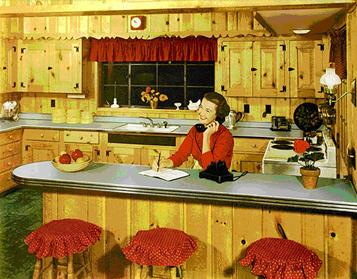
|

|
|
Don't YOU always dress to match the seat
cushions?
1952 Formica demonstration kitchen
pdxmonthly.com/producers/ courtesy-of-retrorenovation
|
OK,
so they can't spell "refrigerator."
(from ad by the
builder of Ron's family home in
Hicksville
)
New York
Daily News March 3, 1951
|
My
family home's kitchen wasn't as grandiose as the one above, but it
did have a linoleum floor, knotty pine cabinets with faux wrought-iron
hardware, curvy/pointy moldings, Formica
counters with metal edges, matching Formica
backsplash behind the counters, and a porcelain sink like the one in
the photo.
Note that the flower pot is positioned to help distract the viewer from
the electric range, and that we cannot see the refrigerator - mixing
white appliances with knotty pine and 1950s colors was not to
everyone's taste.
Before talking about appliances, let's mention the "elephant in the
room." It wasn't really
in the kitchen; it was in the living room, and it wasn't an elephant;
it was a TV. Even without
colors, television was proving effective at "helping us decide what we
wanted". Maybe our
family's 8½ cubic foot refrigerator wasn't big enough, and our
parents wanted to try squeezing a larger one into our kitchen.
|
What
sizes did this year's fridges come in, and what kind of
features did they have? There
were newspaper ads, of course, but television commercials seemed
more informative. They
showed you how things worked, because, say, Betty Furness
demonstrated them.
A
one-time actress, Furness was an early TV "celebrity"
spokesperson. It had
been more than a decade since she appeared in a real movie, but
people knew her name. More
important to Westinghouse, her employer, was that television
viewers listened to her, and responded by going out and buying
Westinghouse products. The
more she did it, the more the viewers trusted her.
|
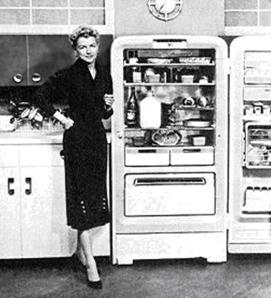
|
|
|
Betty
Furness on the job
iberkshires.com
|
Of
course our parents knew that advertising was biased, but so what?
It was a new era. People
had never owned post-war appliances before; who could know which ones
would last and which would fail? If
Betty Furness showed you that you could get features you liked, why
not buy a Westinghouse?
|
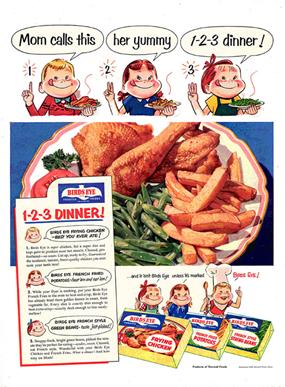
|
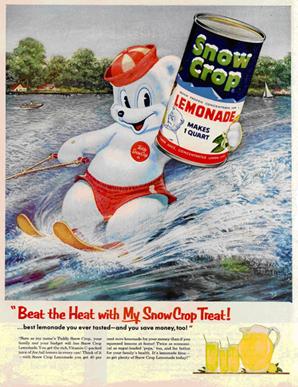
|
|
1952 Birds Eye magazine advertisement
ebay.com
|
1955 magazine ad for Snow Crop Lemonade
amazon.com
|
Whatever
cold appliance - sometimes our parents still called it an "ice
box" - graced our kitchen, inside it was something never before
eaten on a grand scale by humans: frozen edible matter.
In theory, frozen food had existed for many decades, but it
invariably meant miserable, soggy meals with no flavor.
The 1920s saw a breakthrough - a Brooklynite named Clarence
Birdseye invented a quick-freeze process, and frozen foods started
to get better. It would take
a long time to make proper commercial freezing equipment, and to
overcome public skepticism.
In 1945, the war (always the war,
the war...) had left manufacturers with access to plenty of
aluminum, but with few uses for it.
Ecological impacts were not a concern, and it was not long until
someone discovered the most significant scientific formula of the 1950s:
Frozen
Food + Disposable Aluminum Tray = TV Dinner
Meanwhile,
our parents' kitchens accrued more electric gadgets: blenders,
hand-held mixers, rotisseries, percolators, frying pans, griddles, even
pressure cookers. I doubt
that - to use the phrase from the earlier ad - "Mom's chores"
got any better, but because of all the electrical doodads, the
occasional LILCO power outages
(e.g., during hurricanes) had a bigger impact in the kitchen than they
might have had otherwise.
|

|
|
Osrow
Infra-Red Defroster
picclick.com
|
One
of my regular childhood chores was helping my mother defrost the freezer
part of the fridge. I always
expected it to be fun, and it never was.
It was messy; water would get everywhere.
The first step after turning off the fridge was to empty the
contents, and wrap them in multiple layers of newspaper to keep them
cold while the freezer defrosted. Keeping
the dog and cat away was essential.
Although we bought defrosting tools, similar to the one shown above,
they never helped much. We
had to pry off the ice as it softened, and sponge up the water that
gathered in the bottom of the fridge.
Some water always collected in some hidden spot until it decided
to cascade out onto the kitchen floor.
My parents soon bought a new "Self Defrost" refrigerator.
When ice built up, you simply pressed a button, something inside
heated up, and the ice quickly melted into a tray at the bottom of the
unit. Amazing.
After several months, the new refrigerator developed a strange aroma -
not the food in it, but the appliance itself.
It was as if the odor came from inside its walls, and it did.
The "Self Defrost" wiring had ignited the insulation within
the sides of the fridge, and it began to smolder.
On the shiny white outside, tan blotches began to grow, as the
paint got singed from the heat below the surface.
The refrigerator literally "was toast" - it was not a
Westinghouse; maybe my parents should have listened to Betty Furness.
That's
the end of Part I.
Next month, we'll look back on the rest of our journey to the
summer of 1964.
We were the ones in school, but our parents learned alongside us in
those years. There always
were new things in the news, like inflation,
satellites, and transistors,
and new people, too, like Gagarin,
Khrushchev, Clay, and King.
Places we'd known only as dots on a map acquired new, and
sometimes very personal, meanings for us, as we'd hear about
Suez
,
Berlin
,
Vietnam
, and
Dallas
.
|




















